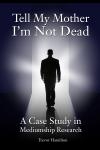
The book splits neatly into two parts. The first talks about Ralph and the effect of his death on Trevor, his wife Anne, and Ralph’s brother, as they go through the grieving process. Embedded in these personal reflections Hamilton describes a series of ten visits to mediums, of varying quality, over a nine-year period, describing the experience, listing the statements, and subjecting these to close analysis. An appendix tabulates the statements, and in the best session the correct ones accounted for 90% of the total made.
During visits Hamilton was alert to issues of body language, fishing, cold reading, generalisations, even the law of large numbers, and factored these into his assessment. Along with the low incidence of errors, he found very few examples of a scattershot throwing-out of names and assertions in the hope that something would stick, and while some of the statements could apply to a large number of people (the Forer/Barnum Effect), many were precise in relating to his situation. The consistency of a number of the readings constitute, he feels, a kind of replication, so often elusive in paranormal research.
The second part opens out the discussion by assessing the evidence for survival of bodily death arising from his personal experiences, set it in the context of investigations of many kinds undertaken by researchers around the world. He draws on a wide range of sources, and the result is a fascinating case study which also acts as a useful summary of the current state of research. He finds much of value, but all too often underreported and ignored by the wider scientific community. The discussion is broken down into eight main headings, useful questions for anyone with an interest in the subject to consider:
1 How accurate was the information the medium provided and how much of it could have been obtained by prior research? (the latter of course is becoming an acute issue in the internet age)
2 What other explanations (apart from the paranormal) could there be for the provision of accurate information?
3 Can a sitter replicate phenomena across a number of mediums and does this support or weaken the survival hypothesis?
4 Are there any examples of high quality historical and contemporary performances by mediums, under acceptable conditions, that would support the survival hypothesis?
5 Are there converging lines of evidence from other sources that would support and corroborate the survival hypothesis?
6 Given positive results from the above lines of enquiry, does this necessarily mean that the source of the information is a discarnate personality?
7 Is it possible to identify those conditions which make for successful sittings and what are the implications of this for the guidance and training of sitters, mediums, and researchers?
8 What does evidence from mediumship tell us about the nature and experience of the ‘we’ that might survive, and are there any lessons we can draw from this as to how we should live our lives here and now?
Hamilton goes into all of these issues, and he spends some time examining the super-psi alternative (gaining knowledge by telepathy or clairvoyance) as an alternative explanation to the survival hypothesis. The book concludes with a useful glossary of terms and an extensive list of references.
He is fully aware that the death of a loved one can affect perceptions (the family occasionally thought that they could smell Ralph’s cigarette smoke at home, and an electric light behaved oddly; it would have been easy to read these as signs of Ralph’s presence). Obsessively visiting mediums can become an emotional crutch, and Hamilton is always careful to remain level-headed and not let his personal situation cloud his judgement. He is conscious of the pitfalls, the tricks mediums can use to persuade the sitter that the messages are genuine, and the danger of projecting meaning onto their utterances. He has had to navigate the twin dangers of being overly-sceptical and overly-credulous, and for anyone contemplating travelling the same route, there are valuable lessons here in how to go about it, and how to interpret what you are told.
It is clear from this overview that we need to know more about mediumship and its validity. Hamilton bemoans the small volume of scientifically rigorous research being conducted, and the paucity of funding available. The situation has improved somewhat in recent years and he hopes that resources can be found to enable research to proceed at a faster pace. This effort should be multi-disciplinary, he argues, encompassing scrutiny of the implications of altered states of consciousness, mediumship training to obtain the optimal conditions, and including other aspects of survival research such as Instrumental Transcommunication, near-death experiences, after death communications, and reincarnation.
Hamilton’s tentative conclusion from the strands he examines – the historical record (much of it accumulated by the SPR), the current state of play in psychical research, and his own interactions with mediums – is that while some are stronger than others, there is good evidence that the personality can survive the death of the body; though what form the afterlife might take is unclear. The book is very readable, aimed at a general, non-technical audience, a worthy addition to the studies analysing mental mediumship, its drawbacks and benefits. It is an absorbing discussion of what light can be thrown on the survival of the human personality following bodily death.

